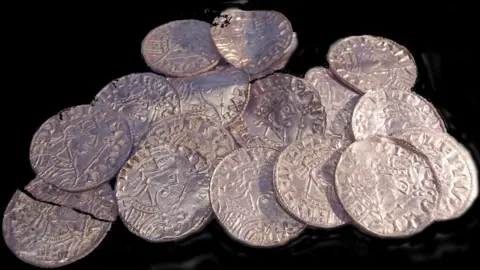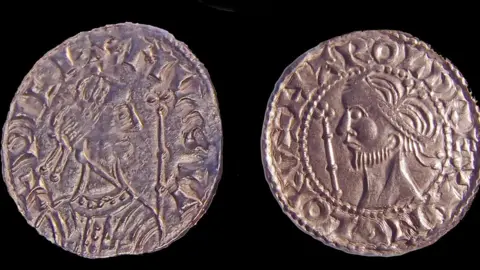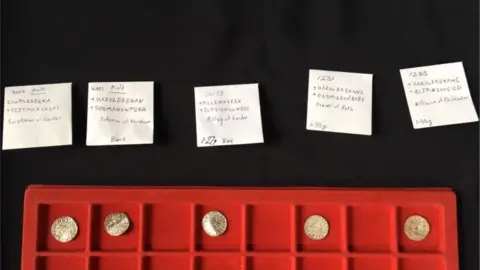Detectorists find huge Chew Valley Norman coin hoard
 Pippa Pearce
Pippa PearceA huge hoard of silver coins dating back to the aftermath of the Battle of Hastings could be declared as treasure.
The 2,528 silver coins were found in the Chew Valley, north-east Somerset, by a group of metal detectorists.
Lisa Grace and Adam Staples, who unearthed the bulk of the hoard, said: "We've been dreaming of this for 15 years but it's finally come true."
The British Museum said it was the second largest find of Norman coins ever in the UK.
Mr Staples, from Derby, added: "It was totally unbelievable - to find one would be an exceptional day metal detecting.
"To find two unrelated coins would be almost impossible. And when there were more beeps, from two to 10, from 50 to 100, to wow how many are there?
"From then on it was just crazy."
 Getty Images
Getty ImagesThe coins, which date from just after the Battle of Hastings in 1066, depict both the defeated King Harold II and the triumphant William the Conqueror.
If the hoard is officially declared as treasure, the Roman Baths in Bath hopes to acquire the coins.
Stephen Clews, from the Roman Baths, said: "If you look at the true value of this, it's about 500 sheep - that's what you would have been to able to buy with them about 1,000 years ago.
"So what we need to do is translate that into some sort of modern value."
The Chew Valley hoard contains 1,236 coins of Harold II, the last crowned Anglo-Saxon king of England, and 1,310 coins of William I, as well as several coin fragments.
 Getty Images
Getty ImagesMr Staples, 43, said he and his girlfriend were training five friends to use their metal detectors on a weekend trip when they made the discovery.
The first coin, of William the Conqueror, was found by a friend, with the bulk of the hoard found by Mr Staples and his partner.
While the coins have not been officially valued, they could be worth about £5m which would be shared among the whole group and the landowner, Mr Staples added.
Mr Staples said of the dig: "We didn't leave the site until we thought we'd got all the coins...
"We had a massive thunder and rainstorm. We were all soaking wet by the time we finished."

What is treasure?
- Under the Treasure Act 1996, finders of potential treasure in England, Wales and Northern Ireland are legally obliged to notify their local coroner
- An inquest then determines whether the finds constitute treasure
- The act contains a number of definitions of "treasure", including prehistoric objects, coins that contain gold or silver and are at least 300 years old, or more recent valuable objects that have been deliberately hidden
- If the find is declared treasure, the finder must offer it for sale to a museum at a price set by the British Museum's Treasure Valuation Committee
- A reward is then offered to the finders and other relevant parties

Ms Grace, 42, joked: "It was like the gods didn't want to disturb the hoard... We were wet through but it really didn't seem to matter."
Experts say the "very well-preserved" hoard is "hugely significant" as it contains double the number of Harold coins than all previous known finds combined.
It also includes further examples of coins issued by William I after his coronation on Christmas Day in 1066.
Initial studies indicate previously unrecorded mints for both kings' coins in the haul.
 Pippa Pearce
Pippa PearceGareth Williams, curator of early medieval coinage at the British Museum, said: "This is an extremely significant find for our understanding of the impact of the Norman Conquest of 1066.
"One of the big debates amongst historians is the extent to which there was continuity or change, both in the years immediately after the conquest and across a longer period."
Some "mule" coins in the hoard have designs from dies of both reigns on either side.
 Pippa Pearce
Pippa PearceExperts say this is an early example of tax evasion as the coin maker would re-use an outdated die on one side to avoid paying a fee to obtain the up-to-date design.
Senior conservator Pippa Pearce added the coins were "very well preserved" due to "a lucky combination of good quality silver going into ground that contains nothing too corrosive".
Paul Crossley, from Bath and North East Somerset Council, said: "If we are able to acquire the coins, we will work to display them locally, as well as partnering with the British Museum to make them available for loan to other exhibitions so that they can be seen by a wider audience."
The find has yet to be declared as treasure by the Avon coroner.

